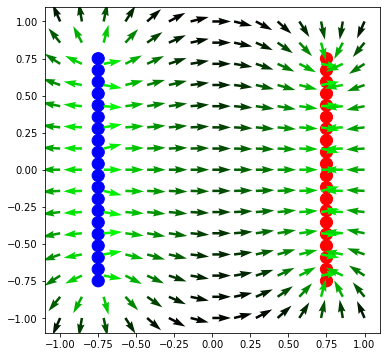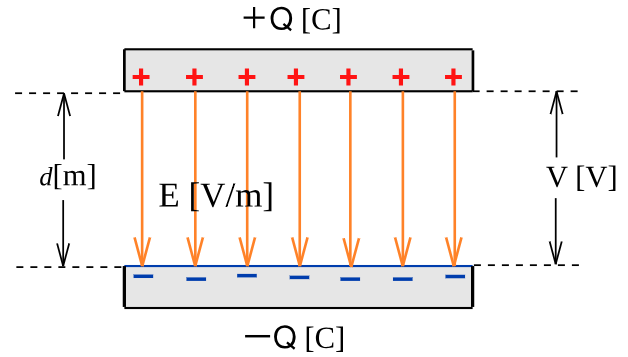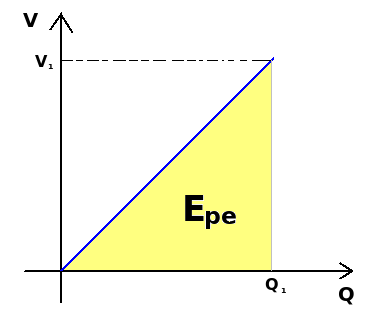Capacitors, along with resistors, are the most common electronic components in electronic circuits. A capacitor is a device that can store an electric charge, or potential energy, in the form of electrical field energy. Electrical field vectors between two plates with opposite charge potentials can be seen on image below:

The physical quantity that describes the ability to store charge, and thus the energy of an electric field, is called electric capacitance and marked with letter C. Unit for capacitance is Farad marked with letter F.
ELECTRIC CAPACITANCE
Energy in the form of an electric charge in electric capacitor is stored when an electric voltage is applied between two conductive surfaces (electrodes, capacitor plates) separated by a non-conductive layer (insulator). The electric charge on one conductive surface of the electric capacitor is equal in absolute value to the electric charge on the other conductive surface, but of opposite sign.

The electric capacitance of a parallel-plate capacitor is proportional to the dielectric permittivity “ε” of the insulator. Capacitance is greater when the area of the plates “S” is larger and when the distance “d” between the plates is smaller. Therefore, the capacitance “C” is given by the formula:
C – Electric capacitance in Farads [F]
S – Surface area of the plates in square meters [m2]
d – Distance between plates in meters [m]
If the charge “Q” of a capacitor is measured as a function of the voltage “U” of the voltage source to which the capacitor is connected, it can be concluded that the amount of charge stored is proportional to the applied voltage:
Q – Electric charge in Coulomb [C]
C – Electric capacitance in Farads [F]
U – Voltage on capacitor plates in Volts [V]
The proportionality constant “C” is called the electric capacitance or capacitance of the capacitor.
STORED ELECTRIC POTENTIAL ENERGY IN CAPACITOR
As the voltage increases, the amount of charge stored also increases, while the capacitance remains unchanged. The potential energy stored in capacitor is given by the area under the blue line:

The potential energy stored in the electric field of a capacitor is given by the equation:
Epe – Electric potential energy in Joule [J]
Q – Electric charge in Coulomb [C]
U – Voltage on capacitor plates in Volts [V]
Since Q=CU, we can derive an equation that includes voltage and capacitance, two common values in electric circuits, making it easier to calculate the stored potential energy in a capacitor:
Epe – Electric potential energy in Joule [J]
C – Electric capacitance in Farads [F]
U – Voltage on capacitor plates in Volts [V]
CAPACITOR DIELECTRIC AND DIELECTRIC PERMITTIVITY
A capacitor consists of two main components: conductive electrodes and a dielectric material placed between them. The electrodes store opposite charges, creating an electric field between them. The dielectric material, an insulator, is essential because it prevents the charges on the electrodes from directly neutralizing each other, which would eliminate the stored energy.
If the dielectric were absent or inadequate (i.e., not a good insulator), the charges would discharge across the electrodes, dissipating the electric field and the stored energy in the capacitor. The quality of the dielectric material directly influences the capacitor’s ability to store energy and its overall efficiency.
The dielectric’s role is crucial for the following reasons:
Insulation:
It prevents direct electrical contact between the conductive plates, thereby maintaining the separation of opposite charges. Without a proper dielectric, the charges would neutralize, eliminating the stored energy.
Field Enhancement:
The dielectric material increases the capacitor’s ability to store charge for a given voltage by reducing the effective electric field within the material. This is quantified by its permittivity ε, which is typically higher than that of a vacuum.
Energy Storage:
The dielectric material allows the capacitor to store more energy. The energy stored in capacitor is proportional to capacitance and capacitance is directly proportional to the dielectric constant of the material.
Dielectric permittivity can also be represented as:
ε – Dielectric permittivity in Farads per meter [F/m]
ε0 – Dielectric permittivity of vacuum in Farads per meter [F/m]
εr – Relative dielectric permittivity
Relative dielectric permittivity describes how many times greater the electrical capacitance of a capacitor is when a specific dielectric is placed between its electrodes instead of a vacuum.
For example the relative dielectric permittivity of vacuum is 1, of air is 1.00594, of paraffin is 4 to 8, of glass is 5 to 10, of acetone is 21, of hydrofluoric acid is 84.6, and of strontium titanate is 310.
Vacuum permittivity, is the value of the absolute dielectric permittivity of classical vacuum. It may also be referred to as the permittivity of free space, the electric constant, or the distributed capacitance of the vacuum. It is an ideal (baseline) physical constant. Its value is:


Leave a Reply